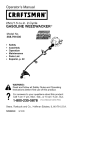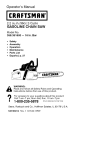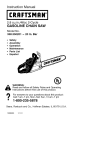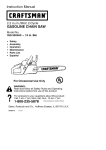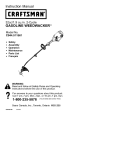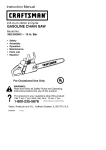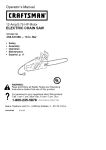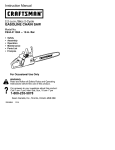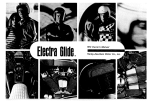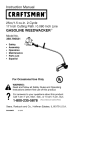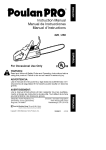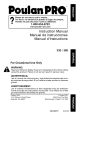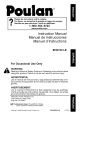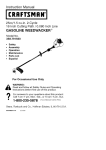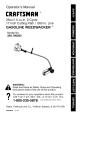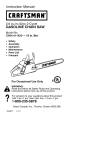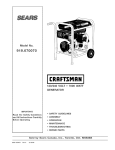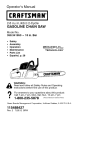Download Operator`s Manual GASOLINE CHAIN SAW 1-800-235
Transcript
Operator's
Manual
_
S
P
R 0
F
E S
2.4 cu.in./40cc
GASOLINE
Model No.
358.362180
•
I
0
N
A
L_
2-Cycle
CHAIN
SAW
- 18 in. Bar
Safety
• Assembly
•
•
Operation
Maintenance
•
Parts List
•
Espa_ol,
p. 26
WARNING:
Read and follow all Safety Rules and Operating
Instructions
before first use of this product.
For answers
Call 7 am-7
to your questions about this product:
pm, Mon-Sat;
Sun, 10 am-7 pm
1-800-235-5878
Sears, Roebuck
545177366
(Hours
and Co., Hoffman
Rev. 3 5/7/08
BRW
listed are Central Time)
Estates,
IL 60179 U.S.A.
Warranty
Safety Rules
Assembly
Operation
Maintenance
Service and Adjustments
2
2
6
7
14
17
Storage
Troubleshooting
Table
Emissions Statement
Parts List
Spanish
Parts & Ordering
18
19
21
23
26
Back Cover
CRAFTSMAN
PROFESSIONAL
FULL WARRANTY
When used and maintained according to the operator's manual, if this product fails
due to a defect in material or workmanship within three (3) years from the date of
purchase, return it to any Sears store, Sears Service Center, or other Craftsman outlet in the United States for free repair (or replacement if repair proves impossible).
This warranty applies for only 1 year from purchase date if this product is ever
used for commercial or rental purposes.
This warranty covers ONLY defects in material and workmanship.
Sears will
NOT pay for:
• Expendable items that can wear out from normal use within the warranty period,
such as bars, chains, filters or spark plugs.
• Repairs necessary because of accident or failure to operate or maintain the
product according to all supplied instructions.
• Preventive maintenance, or repairs necessary due to improper fuel mixture,
contaminated or stale fuel.
This warranty gives you specific legal rights, and you may also have other rights
which vary from state to state.
Sears, Roebuck and Co., Hoffman
Estates, IL 60179
WARNING:
Always disconnect
spark plug wire when making repairs except for carburetor adjustments. Because a chain saw is a high-speed
wood-cutting tool, special precautions
must be observed to reduce the risk of
accidents. Careless or improper use of
this tool can cause serious injury.
PLAN AHEAD
• Restrict the use of your saw to adult
users who understand and can follow
safety rules, precautions, and operating instructions found in this manual.
Hearing
Protection
Snug
Fitting
Clothing
Safety
Shoes
_
"_ II,I_
Safety Hat
Eye
Protection
Heavy Duty
Gloves
Safety Chaps
• Wear protective gear. Always use
steel-toed safety footwear with non-slip
soles; snug-fitting clothing; heavy-duty,
non-slip gloves; eye protection such
as non-fogging, vented goggles or
face screen; an approved safety hard
hat; and sound barriers (ear plugs or
mufflers) to protect your hearing. Regular users should have hearing
checked regularly as chain saw noise
can damage hearing.
• Secure hair above shoulder length. Do
not wear loose clothing or jewelry; they
can get caught in moving parts.
• Keep all parts of your body away from
the chain when the engine is running.
• Keep children, bystanders, and animals a minimum of 30 feet (10 meters) away from the work area when
starting and using the saw.
• Do not handle or operate a chain
saw when you are fatigued, ill, or upset, or if you have taken alcohol,
drugs, or medication. You must be in
good physical condition and mentally
alert. If you have any condition that
might
beaggravated
bystrenuous may cause damage to the unit and
work,
check
withdoctor
before
oper- possible injury to the operator or byating.
standers. Use only Craftsman acces• Donotstartcutting
untilyouhavea
sories and replacement parts as recclear
workarea,
secure
footing,
and, ommended. Never modify your saw.
ifyouarefelling
trees,
aplanned
re- • Maintain chain saw with care.
treatpath.
• Keep unit sharp and clean for better
OPERATE
YOUR
SAW
SAFELY
and safer performance.
• Donotoperate
achain
sawwithone • Follow instructions for lubricating and
hand.
Serious
injury
totheoperator, changing accessories.
helpers,
bystanders
oranycombina- • Check for damaged parts. Before furtionofthese
persons
mayresult
from ther use of the chain saw, a guard or
one-handed
operation.
Achain
saw
other part that is damaged should be
isintended
fortwo-handed
use.
carefully checked to determine that it
• Operate
thechain
sawonlyinawell- will operate properly and perform its
ventilated
outdoor
area.
intended function. Check for alignment
• Donotoperate
sawfromaladder
or
of moving parts, binding of moving
inatree.
parts, breakage of parts, mounting and
• Make
surethechain
willnotmake
any other conditions that may affect its
contact
withanyobject
whilestarting operation. A guard or other part that is
theengine.
Never
trytostartthesaw damaged should be properly repaired
or replaced by a Sears Service Center
when
theguide
barisinacut.
unless otherwise indicated elsewhere
• Donotputpressure
onthesawat
theendofthecut.Applying
pressure in the operator's manual.
cancause
youtolosecontrol
when • When not in use, chain saws should
thecutiscompleted.
be stored in a dry, high or locked-up
• Stopengine
before
setting
sawdown. place out of the reach of children.
• Hand
carrysawonlywhen
engine
is • When storing saw, use a scabbard or
stopped.
Carry
withmuffler
away
carrying case.
frombody;
guide
bar&chainproject- HANDLE FUEL WITH CAUTION
ingbehind
you;guide
barpreferably • Do not smoke while handling fuel or
covered
withascabbard.
while operating the saw.
• Donotoperate
achain
sawthatis
• Eliminate all sources of sparks or
damaged,
improperly
adjusted,
or
flame in the areas where fuel is
notcompletely
andsecurely
asor poured.
sembled.
Always
replace
bar,chain, • mixed
Mix and pour fuel in an outdoor area
handguard,
orchainbrake
immedi- and use an approved, marked conatelyifitbecomes
damaged,
broken tainer for all fuel purposes. Wipe up
orisotherwise
removed.
all fuel spills before starting saw.
MAINTAIN YOUR SAW IN GOOD
WORKING ORDER
,_WARNING:
Disconnect
the
spark plug before performing maintenance except carburetor adjustments.
• Have all chain saw service performed
by a qualified service dealer with the
exception of the items listed in the
MAINTENANCE section of this manual.
• Make certain the saw chain stops
moving when the throttle trigger is
released. For correction, refer to
CARBURETOR ADJUSTMENT.
• Keep the handles dry, clean, and
free from oil or fuel mixture.
• Keep caps and fasteners securely
tightened.
• Nonconforming replacement components or the removal of safety devices
• Move at least 10 feet (3 meters) from
fueling site before starting engine.
• Turn the engine off and let saw cool
in a non-combustible
area, not on
dry leaves, straw, paper, etc. Slowly
remove fuel cap and refuel unit.
• Empty the fuel tank before storing or
transporting the unit. Use up fuel left in
the carburetor by starting the engine
and letting it run until it stops.
• Store the unit and fuel in an area
where fuel vapors cannot reach
sparks or open flames from water
heaters, electric motors or switches,
furnaces, etc.
GUARD AGAINST KICKBACK
Follow all safety rules to help avoid
kickback and other forces which can
result in serious injury.
%_ _
,_WARNING"
Kickback
Path
Avoid kickback
which can result in serious injury.
Kickback is the backward, upward or
sudden forward motion of the guide
bar occurring when the saw chain near
the upper tip of the guide bar contacts
any object such as a log or branch, or
when the wood closes in and pinches
the saw chain in the cut. Contacting a
foreign object in the wood can also result in loss of chain saw control.
• Rotational Kickback
can occur
when the moving chain contacts an
object at the upper tip of the guide
bar. This contact can cause the
chain to dig into the object, which
stops the chain for an instant. The
result is a lightning fast, reverse
reaction which kicks the guide bar up
and back toward the operator.
• Pinch-Kickback
can occur when the
the wood closes in and pinches the
moving saw chain in the cut along
the top of the guide bar and the saw
chain is suddenly stopped. This sudden stopping of the chain results in a
reversal of the chain force used to
cut wood and causes the saw to
move in the opposite direction of the
chain rotation. The saw is driven
straight back toward the operator.
• Pull-In can occur when the moving
chain contacts a foreign object in the
wood in the cut along the bottom of
the guide bar and the saw chain is
suddenly stopped. This sudden stopping pulls the saw forward and away
from the operator and could easily
cause the operator to lose control of
the saw.
REDUCE THE CHANCE OF
KICKBACK
• Recognize that kickback can happen. With a basic understanding
of
kickback, you can reduce the element of surprise which contributes to
accidents.
• Never let the moving chain contact
any object at the tip of the guide bar.
• Keep the working area free from obstructions such as other trees,
branches, rocks, fences, stumps,
etc. Eliminate or avoid any
obstruction that your saw chain could
hit while you are cutting.
• When cutting a branch, do not let the
guide bar contact branch or other objects around it.
• Keep saw chain sharp and properly
tensioned. A loose or dull chain can
increase the chance of kickback. Follow manufacturer's chain sharpening
and maintenance instructions. Check
tension at regular intervals, but never
with the engine running. Make sure
the bar nuts are securely tightened.
• Begin and continue cutting at full
speed. If the chain is moving at a
slower speed, there is greater
chance of kickback occurring.
• Use extreme caution when re-entering a previous cut.
• Do not attempt cuts starting with the
tip of the bar (plunge cuts).
• Watch for shifting logs or other forces
that could close a cut and pinch or
fall into chain.
• Use the Reduced-Kickback
Guide
Bar and Low-Kickback
Chain specified for your saw.
Avoid Pinch-Kickback:
• Be extremely aware of situations or
obstructions that can cause material
to pinch the top of or otherwise stop
the chain.
• Do not cut more than one log at a
time.
• Do not twist the saw as the bar is
withdrawn from an undercut when
bucking.
Avoid Pull-In:
• Always begin cutting with the engine
at full speed and the saw housing
against wood.
• Use wedges made of plastic or wood.
Never use metal to hold the cut open.
MAINTAIN CONTROL
Stand to the left of the saw
underside
tl
reduces the size of the kickback
danger zone on the bar tip. This type
of bar has been demonstrated to significantly reduce the number and seriousness of kickbacks when tested
in accordance with ANSI B175.1.
/
.
_
4# S
Tip Guide Bar
\\
_
Elbow
locked
Never reverse hand positions
Large Radius [
Tip Guide Bar
_'
• A good, firm grip on the saw with both
hands will help you maintain control.
Don't let go. Grip the rear handle with
your right hand whether you are right
or left handed. Wrap the fingers of
your left hand over and around the
front handlebar, and your left thumb
under the front handlebar. Keep your
left arm straight with the elbow locked.
• Position your left hand on the front
handlebar so it is in a straight line
with your right hand on the rear
handle when making bucking cuts.
Never reverse right and left hand
positions for any type of cutting.
• Stand with your weight evenly balanced on both feet.
• Do not overreach. You could be
drawn or thrown off balance and lose
control of the saw.
• Do not cut above shoulder height. It
is difficult to maintain control of saw
above shoulder height.
KICKBACK
SAFETY FEATURES
_ILWARNING:
WE DO NOT REPRESENT AND YOU SHOULD NOT ASSUME THAT THE CHAIN BRAKE WILL
PROTECT YOU IN THE EVENT OF A
KICKBACK. Kickback is a lightning fast
action which throws the bar and rotat-
_,WARNING:
The following features are included on your saw to help
reduce the hazard of kickback; however,
such features will not totally eliminate
this danger. Do not rely only on safety
devices. Follow all safety rules to help
avoid kickback and other forces which
can result in serious injury.
• Front Hand Guard, designed to reduce
the chance of your left hand contacting the chain if your hand slips off the
front handlebar.
• Position of front and rear handlebars,
designed with distance between handles and "in-line" with each other. The
spread and "in-line" position of the
hands provided by this design work
together to give balance and resistance in controlling the pivot of the
saw back toward the operator if kickback occurs.
• Reduced-Kickback
Guide Bar, designed with a small radius tip which
ing chain back and up toward the operator. Kickback can be caused by allowing contact of the bar tip in the
danger zone with any hard object.
Kickback can also be caused by
pinching the saw chain along the top
of the guide bar. This action may push
the guide bar rapidly back toward the
operator. Either of these events may
cause you to lose control of the saw
which could result in serious injury or
even death. DO NOT RELY UPON ANY
OF THE DEVICES BUILT INTO YOUR
SAW. YOU SHOULD USE THE SAW
PROPERLY AND CAREFULLY TO AVOID
KICKBACK. Reduced-kickback
guide
bars and low-kickback
saw chains reduce the chance and magnitude of
kickback and are recommended. Your
saw has a low kickback chain and bar
as original equipment. Repairs on a
chain brake should be made by an authorized Sears Service Center. Take
• Low-Kickback
Chain, has met kickback performance requirements
when tested on a representative
sample of chain saws below 3.8 cubic inch displacement specified in
ANSI B175.1.
Low-Kickback Chain
Contoured Depth Gauge
./
Elongated Guard Link
force And allows
wood
to gradually
deflects
kickback
ride into Cutter
CHAIN BRAKE
• Chain Brake, designed to stop the
chain in the event of kickback.
CHAIN
BRAKE:
Ifthissawistobe
yourunittotheplaceofpurchase
if
purchased
fromaservicing
dealer,
or used
forcommercial
logging,
achain
toyournearest
Sears
Service
Center. brake
isrequired
andshallnotbereorotherwise
disabled
tocom• Tipcontact
insome
cases
maycause moved
alightning
fastreverse
REACTION, plywithFederal
OSHA
Regulations
for
kicking
guide
barupandback
toward Commercial
Logging.
operator.
SPARK
ARRESTING
SCREEN:
Your
• Pinching
thesawchain
along
thetop sawisequipped
withatemperature
oftheguide
barmaypush
theguide
muffler
andspark
arresting
barrapidly
back
toward
theoperator. limiting
screen
which
m
eets
therequirements
• Either
ofthese
reactions
maycause ofCalifornia
Codes
4442and4443.
youtolose
control
ofthesawwhich AllU.S.
forest
landandthestates
of
could
result
inserious
injury.
Donot
California,
Idaho,
Maine,
Minnesota,
relyexclusively
upon
devices
builtinto NewJersey,
Oregon,
andWashington
yoursaw.
require
bylaw
that
m
any
internal
comThisunitisnotequipped
withananti- bustion
engines
tobeequipped
witha
vibration
system
andisintended
for
spark
arresting
screen.
Ifyouoperate
occasional
useonly.
achain
sawinastate
orlocale
where
SAFETY
NOTICE:
Exposure
tovibra- suchregulations
exist,
you
arelegally
tions
through
prolonged
useofgasoline responsible
formaintaining
theoperatpowered
hand
toolscould
cause
blood
condition
ofthese
parts.
Failure
to
vessel
ornerve
damage
inthefingers, ing
dosoisaviolation
ofthelaw.Refer
to
hands,
andjoints
ofpeople
prone
to
Responsibilities
chartin
circulation
disorders
orabnormal
swell- theCustomer
section.
ings.
Prolonged
useincoldweather
has theMAINTENANCE
been
linked
toblood
vessel
damage
in
otherwise
healthy
people.
Ifsymptoms
occur
suchasnumbness,
pain,
lossof
strength,
change
inskincolor
ortexture,
orlossoffeeling
inthefingers,
hands,
or
joints,
discontinue
theuseofthistool
andseekmedical
attention.
Ananti-vibration
system
does
notguarantee
the
avoidance
ofthese
problems.
Users
whooperate
power
toolsonacontinual
andregular
basis
must
monitor
closely
theirphysical
condition
andthecondition
ofthistool.
_WARNING:Before
using
chain
saw,ensure
allfasteners
aresecure.
CARTON
CONTENTS
Check
carton
contents
against
thefollowing
list.
Model
358,362180
• Chain
saw(fully
assembled)
• Chain
adjustment
tool(bar
tool)
• 2-cycle
engine
oil
• Carrying
case
Examine
parts
fordamage.
Donotuse
damaged
parts.
Ifyouneed
assistance
orfindthatparts
aremissing
ordamaged,
please
call
1-800-235-5878.
NOTE:
Itisnormal
tohear
thefuelfilter
rattle
inanempty
fueltank.
Your
unithasbeen
factory
tested
and
thecarburetor
precisely
adjusted.
Asa
result
youmaysmell
gasoline
orfinda
drop
ofoil/fuel
residue
onthemuffler
when
youunpack
theunit.
ASSEMBLY
Yoursawisfullyassembled;
no
assembly
isnecessary.
KNOW
YOUR
CHAIN SAW
READ THIS OPERATOR'S MANUAL AND SAFETY RULES BEFORE OPERATING YOUR
CHAIN SAW. Compare the illustrations with your unit to familiarize yourself with the
location of the various controls and adjustments. Save this manual for future reference.
Starter Rope
Front Hand Guard
Air Filter Cover
/
/
/
Air Filter Cover Knob
/
Bar ,/
Sprocket
Hole
Choke/Fast
Idle Lever
Chain
Front
Handle
Rear Handle
Starter Housin_
Fuel Mix Fill Cap
Chain Adjustment Tool
(Bar Tool)
Throttle
Throttle
Trigger
/
Bar Oil Fill Cap
CylindetCoi_
_,,_
Bar Nuts
_
/
ON/STOP
Muffler
_
_
_} Adjusting Screw
_
Catcher
Switch
Cihreaicr_ion
__
_r_e_J
of Travel
"_
Chain Brake
ON/STOP SWITCH
The ON/STOP SWITCH is used to stop
the engine.
THROTTLE TRIGGER
The THRO-FFLE TRIGGER controls engine speed.
THROTTLE LOCK-OUT
The THRO-FFLE LOCK-OUT must be
pressed before you can squeeze the
throttle trigger. This feature prevents you
from accidentally squeezing the trigger.
CHOKE/FAST IDLE LEVER
The choke and fast idle are set by pulling the CHOKE/FAST IDLE LEVER out to
the full extent for cold starting or after
refueling. The choke provides additional
fuel to the engine during cold starting.
CHAIN BRAKE
The CHAIN BRAKE is a device designed
to stop the chain if kickback occurs. The
chain brake activates automatically in
the event of kickback. The chain brake
activates manually if the front hand
guard is pushed forward. The chain
brake is disengaged by pulling the front
hand guard back toward the front handle
as far as possible.
CHAIN TENSION
It is normal for a new chain to stretch
during the first 15 minutes of operation.
You should check your chain tension
frequently. See CHAIN TENSION under
the MAINTENANCE section.
m_WARNING:
Muffler
isveryhot
during
andafteruse.Donottouch
the
muffler
orallow
combustible
material
suchasdrygrass
orfueltodoso.
BEFORE
STARTING
ENGINE
_IkWARNING:
Be sure to read the
fuel handling information in the safety
rules section of this manual before you
begin. If you do not understand the
fuel handling information do not attempt to fuel your unit. Seek help from
someone that does understand the information or call the customer assistance help line at 1-800-235-5878.
GUIDE BAR AND CHAIN OIL
The bar and chain require lubrication.
The chain oiler provides continuous
lubrication to the chain and guide bar.
Be sure to fill the bar oil tank when you
fill the fuel tank (Capacity = 6.8 ft. oz.).
Lack of oil will quickly ruin the bar and
chain. Too little oil will cause overheating shown by smoke coming from the
chain and/or discoloration
of the bar.
For maximum guide bar and chain life,
we recommend you use Craftsman
chain saw bar oil. If Craftsman bar oil
is not available, you may use a good
grade SAE 30 oil until you are able to
obtain Craftsman brand. The oil output
is automatically metered during operation. Your saw will use approximately
one tank of bar oil for every tank of fuel
mix. Always fill the bar oil tank when
you fill the fuel tank.
FUELING ENGINE
,_IkWARNING:
Remove fuel cap
slowly when refueling.
This engine is certified to operate on
unleaded gasoline. Before operation,
gasoline must be mixed with a good
quality synthetic 2-cycle air-cooled engine oil. We recommend Craftsman
brand synthetic oil. Mix gasoline and
oil ata ratio of 40:1. A40:1 ratio is obtained by mixing 3.2 ounces of oil with
1 gallon of unleaded gasoline. Included
with this saw is a 3.2 ounce container of
oil. Pour the entire contents of this container into 1 gallon of gasoline to
achieve the proper fuel mixture.
DO NOT USE automotive or boat oil.
These oils will cause engine damage.
When mixing fuel follow the instructions printed on the oil container. Once
oil is added to the gasoline, shake
container momentarily to assure that
the fuel is thoroughly mixed. Always
read and follow the safety rules relating to fuel before fueling your unit.
IMPORTANT
Experience indicates that alcoholblended fuels (called gasohol or using
ethanol or methanol) can attract moisture which leads to separation and
formation of acids during storage. Acidic
gas can damage the fuel system of an
engine while in storage. To avoid engine
problems, the fuel system should be
emptied before storage for 30 days or
longer. Drain the gas tank, start the engine and let it run until the fuel lines and
carburetor are empty. Use fresh fuel
next season. Never use engine or carburetor cleaner products in the fuel tank
or permanent damage may occur.
See the STORAGE section for additional
information
CHAIN BRAKE
Ensure chain brake is disengaged by
pulling the front hand guard back toward
the front handle as far as possible. The
chain brake must be disengaged before
cutting with the saw.
_ILWARNING:
The chain must not
move when the engine runs at idle
speed. If the chain moves at idle
speed refer to CARBURETOR ADJUSTMENT within this manual. Avoid contact
with the muffler. A hot muffler can
cause serious burns.
STOPPING YOUR ENGINE
• Release the throttle trigger.
• Move ON/STOP switch to the STOP
position.
STARTING POSITION
• To start the engine, hold the saw
firmly on the ground as illustrated.
Make sure the chain is free to turn
without contacting any object.
Starter Rope Handle
• I
Right Foot Through Rear Handle
IMPORTANT POINTS TO REMEMBER
When pulling the starter rope, do not
use the full extent of the rope as this
can cause the rope to break. Do not let
starter rope snap back. Hold the handle and let the rope rewind slowly.
For cold weather starting, start the unit
at FULL CHOKE; allow the engine to
warm up before squeezing the throttle
trigger.
3.
Pull the starter rope sharply 5 times
with your right hand. Then, proceed to the next step.
NOTE: Ifthe engine sounds as if it is trying to start before the 5th pull, stop pulling and immediately proceed to the next
step.
4. Push the choke/fast idle lever in to
the HALF CHOKE position.
5. Pull the starter rope sharply with
your right hand until the engine
starts.
6. Allow the engine to run for approximately 30 seconds. Then, squeeze
and release the throttle trigger to
allow engine to return to idle
speed.
STARTING A WARM ENGINE
1. Move ON/STOP switch to the ON
position.
2. Pull the choke/fast idle lever out to
the FULL CHOKE position to set the
fast idle, then push the lever in to
the HALF CHOKE position.
3. Pull the starter rope sharply with
your right hand until the engine
starts.
4. Squeeze and release throttle trigger
to allow engine to return to idle
speed.
DIFFICULT STARTING (or starting a
flooded engine)
The engine may be flooded with too
much fuel if it has not started after 10
pulls total. Flooded engines can be
cleared of excess fuel by allowing the
unit to sit for 30 minutes. Ensure ON/
STOP switch is in the ON position; then,
start the unit by following the steps
under STARTING A COLD ENGINE or
following the starting instruction steps
shown on the unit. If engine fails to
start, please call 1-800-235-5878.
CHAIN BRAKE
NOTE: Do not attempt to cut material
with the choke/fast idle lever in the FULL
CHOKE position.
STARTING A COLD ENGINE (or warm
engine after running out of fuel)
NOTE: In the following steps, when the
choke/fast idle lever is pulled out to the
full extent, the correct throttle setting for
starting is set automatically.
Choke/Fast
Lever
Idle
ON/STOP Switch
1.
2.
Move ON/STOP switch to the ON
position.
Pull choke/fast idle lever out to the
full extent (to the FULL CHOKE position).
Choke/Fast Idle Lo_,,_
_LWARNING:
FULL
HALF
Ifthe
brake band is
worn too thin it may break when the
chain brake is triggered. With a broken
brake band, the chain brake will not
stop the chain. The chain brake must
be replaced if any part is worn to less
than 0.020" (0.5 mm) thick. Repairs on
a chain brake should be made by your
Sears Service Center. Take your unit
to the place of purchase or to the nearest Sears Service Center.
OFF
• This saw is equipped with a chain
brake. The brake is designed to stop
the chain if kickback occurs.
9
• Theinertia-activated
chain
brake
is
activated
ifthefronthand
guard
is
pushed
forward,
either
manually
(by
hand)
orautomatically
(bysudden
movement).
• Ifthebrake
isalready
activated,
itis
disengaged
bypulling
thefronthand
guard
backtoward
thefronthandle
asfaraspossible.
• When
cutting
withthesaw,
thechain
brake
mustbedisengaged.
Disengaged
_
Braking function control
CAUTION:
The chain brake must be
checked several times daily. The engine
must be running when performing this
procedure. This is the only instance
when the saw should be placed on the
ground with the engine running.
Place the saw on firm ground. Grip the
rear handle with your right hand and
the front handle with your left hand.
Apply full throttle by fully depressing
the throttle trigger. Activate the chain
brake by turning your left wrist against
the hand guard without releasing your
grip around the front handle. The chain
should stop immediately.
Inertia activating
function control
,_WARNING:
When performing
the following procedure, the engine
must be turned off.
Grip the rear handle with your right hand
and the front handle with your left hand.
Hold the chain saw approximately 14
inches (35 cm) above a stump or other
wooden surface. Release your grip on
the front handle and use the weight of
the saw to let the top of the guide bar
fall forward and contact the stump.
When the tip of the bar hits the stump,
the brake should activate.
OPERATING TIPS
• Check chain tension before first use
and after 1 minute of operation. See
CHAIN TENSION in the MAINTENANCE
section.
• Cut wood only. Do not cut metal, plastics, masonry, non-wood building materials, etc.
• Stop the saw if the chain strikes a
foreign object. Inspect the saw and
repair or replace parts as necessary.
• Keep the chain out of dirt and sand.
Even a small amount of dirt will quickly
dull a chain and thus increase the
possibility of kickback.
• Practice cutting a few small logs using the following techniques to get
the "feel" of using your saw before
you begin a major sawing operation.
• Squeeze the throttle trigger and allow
the engine to reach full speed before
cutting.
• Begin cutting with the saw frame
against the log.
• Keep the engine at full speed the
entire time you are cutting.
• AIIowthe chain to cut for you. Exert
only light downward
pressure. If
you force the cut, damage to the
bar, chain, or engine can result.
• Release the throttle trigger as soon
as the cut is completed,
allowing
the engine to idle. Ifyou run the saw
at full throttle without a cutting load,
unnecessary wear can occur to the
chain, bar, and engine. To maximize operating efficiency, do not
run the engine for longer than 30
seconds at a time at full throttle,
• To avoid losing control when cut is
complete, do not put pressure on
saw at end of cut.
• Stop the engine before setting the
saw down after cutting.
TREE FELLING TECHNIQUES
_EWARNING:
Check for broken or
dead branches which can fall while cutting causing serious injury. Do not cut
near buildings or electrical wires if you
do not know the direction of tree fall, nor
cut at night since you will not be ale to
see well, nor during bad weather such
as rain, snow, or strong winds, etc.
If the tree makes contact with any utility
line, the utility company should be notified immediately.
• Carefully plan your sawing operation
in advance.
• Clear the work area. You need a clear
area all around the tree so you can
have secure footing.
• The chain saw operator should keep
on the uphill side of the terrain as the
tree is likely to roll or slide downhill
after it is felled.
10
Final (felling) cut here, 2 inches
(5 cm) above center of notch.
• Study the natural conditions that can
cause the tree to fall in a particular direction.
Natural conditions that can cause a tree
to fall in a particular direction include:
• The wind direction and speed.
• The lean of the tree. The lean of a
tree might not be apparent due to uneven or sloping terrain. Use a plumb
or level to determine the direction of
tree lean.
• Weight and branches on one side.
• Surrounding trees and obstacles.
Look for decay and rot. If the trunk is
rotted, it can snap and fall toward the
operator. Check for broken or dead
branches which can fall on you while
cutting. Make sure there is enough
room for the tree to fall. Maintain a distance of 2-1/2tree lengths from the nearest person or other objects. Engine
noise can drown out a warning call.
Remove dirt, stones, loose bark, nails,
staples, and wire from the tree where
cuts are to be made.
S
After removing the wood from the
notch, make the felling cut on the opposite side of the notch. This is done
by making a cut about two inches (5
cm) higher than the center of the
notch. This will leave enough uncut
wood between the felling cut and the
notch to form a hinge. This hinge will
help prevent the tree from falling in the
wrong direction.
Plan a clear retreat path to the rear
and diagonal to the line of fall.
_/=
Hinge holds tree on stump and helps
control fall
Opening of
felling cut
/
Plan a clear retreat path
/
-t....
(}-'_-
Direction of Fall
/
45 ° /,_
/4o"
FELLING LARGE TREES
(6 inches (15 cm) in diameter or larger)
The notch method is used to fell large
trees. A notch is cut on the side of the
tree in the desired direction of fall. After
a felling cut is made on the opposite
side of tree, the tree will tend to fall into
the notch.
NOTE: If the tree has large buttress
roots, remove them before making the
notch. If using saw to remove buttress
roots, keep saw chain from contacting
ground to prevent dulling of the chain.
NOTCH CUT AND FELLING THE
TREE
• Make notch cut by cutting the top of
the notch first. Cut through 1/3 of the
diameter of the tree. Next complete
the notch by cutting the bottom of the
notch. See illustration. Once the
notch is cut remove the notch of
wood from the tree.
Closing
notch
/
/
of
NOTE: Before felling cut is complete,
use wedges to open the cut if necessary
to control the direction of fall. To avoid
kickback and chain damage, use wood
or plastic wedges, but never steel or iron
wedges.
• Be alert to signs that the tree is
ready to fall: cracking sounds, widening of the felling cut, or movement in
the upper branches.
• As tree starts to fall, stop saw, put it
down, and get away quickly on your
planned retreat path.
• DO NOT cut down a partially fallen tree
with your saw. Be extremely cautious
with partially fallen trees that may be
poorly supported. When a tree doesn't
fall completely, set the saw aside and
pull down the tree with a cable winch,
block and tackle, or tractor.
11
CUTTING A FALLEN TREE
(BUCKING)
Bucking is the term used for cutting a
fallen tree to the desired log size.
_IkWARNING:
Do not stand on the
log being cut. Any portion can roll
causing loss of footing and control. Do
not stand downhill of the log being cut.
IMPORTANT POINTS
• Cut only one log at a time.
• Cut shattered wood very carefully;
sharp pieces of wood could be flung
toward operator.
• Use a sawhorse to cut small logs.
Never allow another person to hold
the log while cutting and never hold
the log with your leg or foot.
• Do not cut in an area where logs,
limbs, and roots are tangled such as
in a blown down area. Drag the logs
into a clear area before cutting by
pulling out exposed and cleared logs
first.
TYPES OF CUTTING
BUCKING
_/L WARNING:
USED FOR
If saw becomes
pinched or hung in a log, don't try to
force it out. You can lose control of the
saw resulting in injury and/or damage
to the saw. Stop the saw, drive a
wedge of plastic or wood into the cut
until the saw can be removed easily.
Restart the saw and carefully reenter
the cut. To avoid kickback and chain
damage, do not use a metal wedge.
Do not attempt to restart your saw
when it is pinched or hung in a log.
Use a wedge
to remove
pinched
saw
firmly and maintain control. The saw
will tend to push back toward you.
_ILWARNING:
Neverturn saw upside down to undercut. The saw cannot be controlled in this position.
Always make your first cut on the compression side of the log. The compression side of the log is where the pressure of the log's weight is
concentrated.
First cut on compression side of log
!
Second
cut
Second
cut
First cut on compression side of log
BUCKING WITHOUT A SUPPORT
• Overcut through 1/3of the diameter
of the log.
• Roll the log over and finish with a
second overcut.
• Watch for logs with a compression
side to prevent the saw from pinching. See illustrations for cutting logs
with a compression side.
BUCKING USING A LOG OR
SUPPORT STAND
• Remember your first cut is always on
the compression side of the log.
(Refer to the illustrations below for
your first and second cut)
• Your first cut should extend 1/3 of the
diameter of the log.
• Finish with your second cut.
Using a log for support
Turn saw OFF and use a plastic or
wooden wedge to force cut open,
2 nd
/
Cut
Overcutting begins on the top side of
the log with the bottom of the saw
against the log. When overcutting use
light downward pressure.
1st Cut
1st Cut
Undercutting
involves cutting on the
underside of the log with top of saw
against the log. When undercutting
use light upward pressure.
Hold saw
2nd C Ll't"_b- :'-_'._
12
__
Using a support stand
2nd Cut
/
\--_Cut
j 1st Cut
LIMBING AND PRUNING
_/L WARNING:
Be alert for and
guard against kickback. Do not allow the
moving chain to contact any other
branches or objects at the nose of the
guide bar when limbing or pruning. Allowing such contact can result in serious
injury.
_L, WARNING:
Never climb into a
tree to limb or prune. Do not stand on
ladders, platforms, a log, or in any position which can cause you to lose your
balance or control of the saw.
IMPORTANT POINTS
• Work slowly, keeping both hands firmly
gripped on the saw. Maintain secure
footing and balance.
• Watch out for springpoles. Springpoles
are small size limbs which can catch
the saw chain and whip toward you or
pull you off balance. Use extreme caution when cutting small size limbs or
slender material.
• Be alert for springback. Watch out for
branches that are bent or under
pressure. Avoid being struck by the
branch or the saw when the tension
in the wood fibers is released.
• Keep a clear work area. Frequently
clear branches out of the way to avoid
tripping over them.
LIMBING
• Always limb a tree after it is cut
down. Only then can limbing be done
safely and properly.
• Leave the larger limbs underneath the
felled tree to support the tree as you
work.
• Start at the base of the felled tree and
work toward the top, cutting branches
and limbs. Remove small limbs with
one cut.
• Keep the tree between you and the
chain. Cut from the side of the tree
opposite the branch you are cutting.
• Remove larger, supporting branches
with the cutting techniques described
in BUCKING WITHOUT A SUPPORT
• Always use an overcut to cut small
and freely hanging limbs. Undercutting
could cause limbs to fall and pinch the
saw.
PRUNING
_IkWARNING:
Limit pruning to limbs
shoulder height or below. Do not cut if
branches are higher than your shoulder.
Get a professional to do the job.
• Make your first cut 1/3 of the way
through the bottom of the limb.
• Next make a 2nd cut all the way
through the limb. Then cut a third
overcut leaving a 1 to 2 inch (2.5 to 5
cm) collar from the truck of the tree.
4"'i ocoo.cu y
Third cut i_,,_
[7
OO ; O0
13
CUSTOMER
RESPONSIBILITIES
_/LWARNING:
Disconnect the spark plug before performing
except for carburetor adjustments.
i
Before :_After Every Every
Yearly i Service
Use
5
hrs.
25
hrs.
Dates
Use
Fill in dates as you complete
regular service
Check for damaged/worn
parts
_
_,-
Check for loose fasteners/parts
_"
Check chain tension
_"
Check chain sharpness
_"
Check guide bar
_"
Check fuel mixture level
_"
Check guide bar and chain oil
maintenance
_
_"
Inspect and clean unit & decals
Check chain brake
Clean guide bar groove
i
i
i
i
Clean air filter
Clean/inspect
muffler and spark
arresting screen
Replace
spark plug and fuel filter
GENERAL RECOMMENDATIONS
The warranty on this unit does not cover items that have been subjected to
operator abuse or negligence. To receive full value from the warranty, the
operator must maintain unit as
instructed in this manual. Various adjustments will need to be made periodically to properly maintain your unit.
• Once a year, replace the spark plug,
air filter, and check guide bar and
chain for wear. A new spark plug and
air filter assures proper air-fuel mixture
and helps your engine run better and
last longer.
CHECK FOR DAMAGED
OR
WORN PARTS
Contact your Sears Service Center for
replacement of damaged or worn parts.
NOTE: It is normal for a small amount of
oil to appear under the saw after engine
stops. Do not confuse this with a leaking
oil tank.
• ON/STOP Switch - Ensure ON/STOP
switch functions properly by moving
the switch to the STOP position. Make
sure engine stops; then restart engine
and continue.
• Fuel Tank - Do not use saw if fuel
tank shows signs of damage or leaks.
• Oil Tank - Do not use saw if oil tank
shows signs of damage or leaks.
CHECK FOR LOOSE
FASTENERS AND PARTS
• Bar Nuts
• Chain
• Muffler
• Cylinder Shield
• Air Filter
• Handle Screws
• Vibration Mounts
• Starter Housing
• Front Hand Guard
CHECK
CHAIN TENSION
,_ WARNING:
Wear protective
gloves when handling chain. The chain
is sharp and can cut you even when it is
not moving.
Chain tension is very important. Chains
stretch during use. This is especially true
during the first few times you use your
saw. Always check chain tension each
time you use and refuel your saw.
1. Use the screwdriver end of the
chain adjustment tool (bar tool) to
move chain around guide bar to
ensure kinks do not exist. The
chain should rotate freely.
14
.
Guide
_1_ ,,-"',_ Bar
./
Chain Adjustment
Bar Nuts Adjusting
Tool
Screw
(Bar Tool)
2.
3.
Loosen bar nuts until they are
finger tight against the clutch cover.
Turn adjusting screw clockwise until chain solidly contacts bottom of
guide bar rail.
4.
Using bar tool, roll chain around
guide bar to ensure all links are in
bar groove.
5. Lift up tip of guide bar to check for
sag. Release tip of guide bar, then
turn adjusting screw until sag does
not exist.
6. While lifting tip of guide bar, tighten
bar nuts securely with the bar tool.
CHECK CHAIN SHARPNESS
A sharp chain makes wood chips. A
dull chain makes a sawdust powder
and cuts slowly. See CHAIN SHARPENING.
CHECK GUIDE BAR
Conditions which require guide bar
maintenance:
• Saw cuts to one side or at an angle.
• Saw has to be forced through the cut.
• Inadequate supply of oil to bar/chain.
Check the condition of guide bar each
time chain is sharpened. A worn guide
bar will damage the chain and make
cutting difficult.
After each use, ensure ON/STOP
switch is in the STOP position, then
clean all sawdust from the guide bar
and sprocket hole.
To maintain guide bar:
• Move ON/STOP switch to STOR
• Loosen and remove bar nuts and
clutch cover. Remove bar and chain
from saw.
• Clean the oil holes and bar groove
after each 5 hours of operation.
H
Remove Sawdust From
Guide Bar G_OV___,_
_
7.
Use the screwdriver end of the bar
tool to move chain around guide
bar.
8. If chain does not rotate, it is too
tight. Slightly loosen bar nuts and
loosen chain by turning the adjusting screw
1/4 turn counterclockwise. Retighten bar nuts.
9. If chain is too loose, it will sag below the guide bar. DO NOT operate
the saw if the chain is loose.
_IWARNING:
Ifthe saw is operated with a loose chain, the chain
could jump off the guide bar and result
in serious injury.
__
Oil Holes
.
• Burring of guide bar rails is a normal
process of rail wear. Remove these
burrs with a flat file.
• When rail top is uneven, use a flat
file to restore square edges and
sides.
_('7
_
I"1
Worn Groove
File Rail Edges_
and Sides
Square
N N
I U I
I
I
Correct Groove
Replace guide bar when the groove is
worn, the guide bar is bent or cracked,
or when excess heating or burring of the
rails occurs. If replacement is necessary,
use only the guide bar specified for your
saw in the repair parts list or on the decal located on the chain saw.
CHECK FUEL MIXTURE LEVEL
• See FUELING ENGINE under the
OPERATION section.
15
LUBRICATION
Air Filter Housing
Cover-
Air Filter
Housing
Bar Oil Fill Cap
• See GUIDE BAR AND CHAIN OIL under the OPERATION section.
INSPECT AND CLEAN UNIT AND
DECALS
• After each use, inspect complete unit
for loose or damaged parts. Clean the
unit and decals using a damp cloth
with a mild detergent.
• Wipe off unit with a clean dry cloth.
CHECK CHAIN BRAKE
See CHAIN BRAKE in the OPERATION
section.
CLEAN AIR FILTER
CAUTION:
Do not clean filter in gasoline or other flammable solvent to
avoid creating a fire hazard or producing harmful evaporative emissions.
Cleaning the air filter:
A dirty air filter decreases the life and
performance of the engine and increases fuel consumption and harmful
emissions. Always clean your air filter
after 10 tanks of fuel or 5 hours of operation, whichever comes first. Clean
more frequently in dusty conditions.
A used air filter can never be completely cleaned. It is advisable to replace your air filter with a new one after every 50 hours of operation, or
annually, whichever comes first.
1. Loosen knob on air filter cover.
2. Remove air filter cover.
3.
4.
Remove air filter housing.
Clean the air filter housing by splitting the housing into halves and
washing with hot soapy water.
Rinse with clean cool water.
5. Re-assemble
the housing halves
by pressing the rim of the housing
until it clicks. Air dry completely
before reinstalling.
6. Reinstall air filter housing and air
filter cover. Tighten knob securely.
INSPECT MUFFLER AND SPARK
ARRESTING
SCREEN
'_WARNING:
The muffler on this
product contains chemicals known to
the State of California to cause cancer.
As the unit is used, carbon deposits
build up on the muffler and spark arresting screen, and must be removed
to avoid creating a fire hazard or affecting engine performance.
Replace the spark arresting screen if
breaks occur.
Muffler
Spark
Arresting
Screen
--.
---
Exhaust
Outlet
Cover
_k
CLEANING THE SPARK ARRESTING SCREEN
Cleaning is required every 25 hours of
operation or annually, whichever
comes first.
1. Loosen and remove the screw and
two nuts from the exhaust outlet
cover.
2. Remove the exhaust oulet cover.
3. Remove spark arresting screen.
Handle screen carefully to prevent
damage.
16
4.
Clean the spark arresting screen
gently with a wire brush. Replace
screen if breaks are found.
Replace any broken or cracked
muffler parts.
6. Reinstall spark arresting screen, exhaust outlet cover, screw and nuts.
Tighten securely.
REPLACE SPARK PLUG
The spark plug should be replaced
each year to ensure the engine starts
easier and runs better. Ignition timing
is fixed and nonadjustable.
1. Loosen knob on air filter cover.
2. Remove air filter cover.
3. Pull off the spark plug boot.
4. Remove spark plug from cylinder
and discard.
5. Replace with Champion RZ-7C
spark plug and tighten securely
with a 3/4 inch (19 mm) socket
wrench. Spark plug gap should be
0.025 inch (0,6 mm).
6.
7.
Reinstall the spark plug boot.
Reinstall the cylinder cover and 3
screws. Tighten securely.
5.
,_WARNING:
Disconnect
the
spark plug before performing maintenance, service, or adjustments except
for carburetor adjustments.
CHAIN SHARPENING
Chain sharpening requires special
tools. You can purchase sharpening
tools at Sears or go to a professional
chain sharpener.
oot
Air Filter _ _,-_'-'_'-_/_
Cover
REPLACE FUEL FILTER
To replace fuel filter, drain your unit by
running it dry of fuel. Remove fuel cap
and its connected retainer from tank.
Pull filter from tank and remove from
line. Replace and reassemble.
TO REPLACE CHAIN:
1. Move ON/STOP switch to the STOP
position.
2. Remove bar nuts.
3. Remove chain brake.
CHAIN REPLACEMENT
,_ WARNING:
Wear protective
gloves when handling chain. The
chain is sharp and can cut you even
when it is not moving.
It is normal for a new chain to stretch
during the first 15 minutes of operation.
You should recheck your chain tension
frequently and adjust the chain tension
as required. See CHAIN TENSION section.
Chain brake /4,'_ , _
Bar nuts
\
Chain adjustment too!
(Bar tool)
4,
Replace the old chain when it becomes worn or damaged. Use only the
Low-Kickback replacement chain specified in the repair parts list. The correct replacement bar and chain is also
specified on a decal located on the
chain saw.
Turn adjusting screw on bar counterclockwise to move the tensioning rack as far as it will go toward
the front of the bar.
................
/
See your Sears Service Center to replace and sharpen individual cutters
on your chain.
Tensioning Rack
17
/__
--,_
5. Slide
guide
baronbarbolts
until
guide
barstops
against
clutch
drum
sprocket.
Guide
bar
Bar bolts
6.
7.
Remove the old chain.
Carefully remove the chain from the
package. Hold chain with the drive
links as shown.
Tip of
Bar
D!IRECTION OF ROTATION
,_,.... Cutters
Depth Gauge
Drive Links
Place chain over and behind clutch
retainer, fitting the drive links in the
clutch drum sprocket.
9. Fit bottom of drive links between
the teeth in the sprocket in the
nose of the guide bar.
10. Fit chain drive links into bar groove.
11. Pull guide bar forward until chain is
snug in guide bar groove. Ensure
all drive links are in the bar groove.
8.
_WARNING:
Perform the follow-
ing steps after each use:
• Allow the engine to cool, and secure
the unit before storing or transporting.
• Store chain saw and fuel in a well
ventilated area where fuel vapors
cannot reach sparks or open flames
from water heaters, electric motors or
switches, furnaces, etc.
• Store chain saw with all guards in
place and position chain saw so that
any sharp object cannot accidentally
cause injury.
12. Install chain brake.
13. Install bar nuts and finger tighten
only. Do not tighten any further at
this point. Proceed to CHAIN ADJUSTMENT.
CHAIN ADJUSTMENT
See CHAIN TENSION in MAINTENANCE
section.
CARBURETOR
ADJUSTMENT
'I_WARNING:
The chain will be
moving during most of this procedure.
Wear your protective equipment and
observe all safety precautions. The
chain must not move at idle speed.
The carburetor has been carefully set
at the factory. Adjustments may be
necessary if you notice any of the following conditions:
• Chain moves at idle. See IDLE
SPEED-T adjusting procedure.
• Saw will not idle. See IDLE SPEED-T
adjusting procedure.
Idle Speed-T
Allow engine to idle. If the chain moves,
idle is too fast. If the engine stalls, idle is
too slow. Adjust speed until engine runs
without chain movement (idle too fast) or
stalling (idle too slow). The idle speed
screw is located in the area above the
primer bulb and is labeled T
• Turn idle screw (T) clockwise to increase engine speed.
• Turn idle screw (T) counterclockwise
to decrease engine speed.
If you require further assistance or are
unsure about performing this procedure,
contact your Sears Service Center or
call our customer assistance help line at
1-800-235-5878.
• Store chain saw well out of the reach
of children.
SEASONAL
STORAGE
Prepare your unit for storage at the
end of the season or if it will not be
used for 30 days or more.
If your chain saw is to be stored for a
period of time:
• Clean saw thoroughly before storage.
• Store in a clean dry area.
• Lightly oil external metal surfaces
and guide bar.
• Oil the chain and wrap it in heavy paper or cloth.
18
FUEL
SYSTEM
ENGINE
Empty
thefuelsystem
before
storage • Remove
spark
plugandpour1teafor30daysorlonger.
Drain
thegas
spoon
of40:1,2-cycle
engine
oil(air
tank,starttheengine
andletitrununtil cooled)
through
thespark
plugopenpullthestarter
rope8to
thefuellinesandcarburetor
areempty. ing.Slowly
Usefreshfuelnextseason.
10times
todistribute
oil.
spark
plugwithnewoneof
Under
FUELING
ENGINE
intheOPERA-• Replace
typeandheatrange.
TION
section
ofthismanual,
seemes- • recommended
airfilter.
sagelabeled
IMPORTANT
regarding • Clean
Check
entire
unitforloose
screws,
theuseofgasohol
inyourchain
saw.
nuts,
andbolts.Replace
anydamFuelstabilizer
isanacceptable
alteraged,
broken,
orwornparts.
native
inminimizing
theformation
of
ofthenextseason,
fuelgumdeposits
during
storage.
Add • Atthebeginning
useonlyfreshfuelhaving
theproper
stabilizer
tothegasoline
inthefuel
gasoline
tooilratio.
tankorfuelstorage
container.
OTHER
Follow
themixinstructions
found
on
• Donotstoregasoline
fromoneseastabilizer
containers.
Runengine
at
toanother.
least
3minutes
afteradding
stabilizer. • son
Replace
yourgasoline
canifitstarts
Craftsman
40:1,2-cycle
engine
oil(air torust.
cooled)
isblended
withfuelstabilizer.
If
youdonotusethisoil,youcanadda
fuelstabilizer
toyourfueltank.
TROUBLESHOOTING
TABLE
WARNING:
Always
stopunitanddisconnect
spark
plugbefore
performingalloftherecommended
remedies
below
except
remedies
thatrequire
operation
oftheunit.
TROUBLE CAUSE
REMEDY
Engine will not
start or will run
only a few
seconds after
starting.
1. ON/STOP switch in
STOP position.
2. Engine flooded.
3. Fuel tank empty.
4. Spark plug not firing.
5. Fuel not reaching
carburetor.
6. Carburetor requires
adjustment.
7. None of the above.
Engine will
not idle
properly.
Engine will not
accelerate,
lacks power,
or dies under
a load.
1. Move ON/STOP switch to ON.
2. See "Difficult Starting" in the
Operation Section.
3. Fill tank with correct fuel mixture.
4. Install new spark plug.
5. Check for dirty fuel filter; replace.
Check for kinked or split fuel line;
repair or replace.
6. Contact Sears Service (see back cover).
7. Contact
Sears Service
(see back cover).
1. Idle speed set too high
or too low.
2. Low Speed Mixture
requires adjustment.
3. Crankshaft seals worn.
4. Compression
low.
5. None of the above.
1. See "Carburetor Adjustment"
in the
Service and Adjustments Section,
2. Contact Sears Service (see back cover).
1. Air filter dirty.
2. Spark plug fouled.
3. Carburetor requires
adjustment.
4. Exhaust ports or muffler outlets plugged.
5. Compression low.
6. Chain brake engaged.
7. None of the above.
1. Clean or replace air filter.
2. Clean or replace plug and regap.
3. Contact Sears Service (see back cover).
3. Contact
4. Contact
5. Contact
4. Contact
Sears Service
Sears Service
Sears Service
Sears Service
(see back cover).
(see back cover).
(see back cover).
(see back cover).
5. Contact Sears Service (see back cover).
6. Disengage chain brake.
7. Contact Sears Service (see back cover).
19
TROUBLESHOOTING
TABLE - Continued
TROUBLE
CAUSE
REMEDY
Engine
smokes
excessively.
1. Choke partially on.
2. Fuel mixture incorrect.
1. Adjust choke.
2. Empty fuel tank and refill with
correct fuel mixture.
3. Clean or replace air filter.
4. Contact Sears Service (see back cover).
3. Air filter dirty.
4. High Speed Mixture
requires adjustment.
5. Crankcase leak.
Engine
hot.
1. Fuel mixture
runs
incorrect.
2. Spark plug incorrect.
3. High Speed Mixture
set too lean.
4. Exhaust ports or muffler outlets plugged.
5. Carbon build-up on
spark arresting screen.
6. Starter housing dirty
7. None of the above.
Oil inadequate
for bar and
chain
lubrication.
Chain moves
idle speed.
at
Chain does not
move when engine is accelerated.
Chain clatters
or cuts roughly.
Chain stops
within the cut.
Chain cuts at
an angle.
1. Oil tank empty.
2. Oil pump or oil filter
clogged.
3. Guide bar oil hole
blocked.
1. Idle speed requires
adjustment.
2. Clutch requires repair.
5. Contact
Sears Service
(see back cover).
1. See "Fueling Engine" in the Operation
section.
2. Replace with correct plug.
3. Contact Sears Service (see back cover).
4. Contact
Sears Service
5. Clean spark
arresting
(see back cover).
screen.
6. Clean starter housing area.
7. Contact Sears Service (see back cover).
1. Fill oil tank.
2. Contact Sears Service
3. Remove
(see back cover).
bar and clean.
See "Carburetor Adjustment"
in the
Service and Adjustments
Section.
2. Contact Sears Service (see back cover).
1.
1. Chain tension too
tight.
2. Carburetor requires
adjustment.
3. Guide bar rails
pinched.
4. Clutch slipping.
5. Chain brake engaged.
1. See "Check Chain Tension" in the
Maintenance
Section.
2. Contact Sears Service (see back cover).
1. Chain tension
1. See "Check Chain Tension" in the
Maintenance Section.
2. Contact Sears Service (see back cover).
3. Resharpen or replace chain.
4. See "Chain Sharpening" in the
Service and Adjustments Section.
incorrect.
2. Cutters damaged.
3. Chain worn.
4. Cutters dull, improperly
sharpened, or depth
gauges too high.
5. Sprocket worn.
6. Chain installed
backwards.
1. Chain cutter tops not
filed flat.
2. Guide bar burred or
bent; rails uneven.
3. Clutch slipping.
1. Cutters damaged on
one side.
2. Chain dull on one side.
3. Guide bar bent or worn.
3. Repair or replace.
4. Contact Sears Service (see back cover).
5. Disengage chain brake.
5. Contact Sears Service (see back cover).
6. Install chain in right direction.
See "Chain Sharpening" in the
Service and Adjustments Section.
2. Repair or replace guide bar.
1.
3. Contact Sears Service (see back cover).
1. See "Chain Sharpening"
in the
Service and Adjustments Section.
2. See "Chain Sharpening" in the
Service and Adjustments Section.
3. Replace guide bar.
If situations occur which are not covered in this manual, use care and good
judgement. If you need assistance, contact Sears Service or the CUSTOMER
ASSISTANCE HELPLINE at 1-800-235-5878.
20
YOUR WARRANTY RIGHTS AND OBLIGATIONS: The U.S. Environmental
Protection Agency/California Air Resources Board and Sears, Roebuck and
Co., U.S.A., are pleased to explain the
emissions control system warranty on
your year 2007 and later small off-road
engine. In California, all small off-road
engines must be designed, built, and
equipped to meet the State's stringent
anti-smog standards. Sears must warrant the emission control system on your
small off-road engine for the periods of
time listed below provided there has
been no abuse, neglect, or improper
maintenance of your small off-road engine. Your emission control system includes parts such as the carburetor, the
ignition system and the fuel tank (California only). Where a warrantable condition
exists, Sears will repair your small offroad engine engine at no cost to you.
Expenses covered under warranty include diagnosis, parts and labor.
MANUFACTURER'S
WARRANTY
COVERAGE: If any emissions related
part on your engine (as listed under
Emissions Control Warranty Parts List) is
defective or a defect in the materials or
workmanship of the engine causes the
failure of such an emission related part,
the part will be repaired or replaced by
Sears. OWNER'S WARRANTY RESPONSIBILITIES: As the small off-road
engine engine owner, you are responsible for the performance of the required
maintenance listed in your operator's
manual. Sears recommends that you
retain all receipts covering maintenance
on your small off-road engine, but Sears
cannot deny warranty solely for the lack
of receipts or for your failure to ensure
the performance of all scheduled maintenance. As the small off-road engine
engine owner, you should be aware that
Sears may deny you warranty coverage
if your small off-road engine engine or a
part of it has failed due to abuse, neglect, improper maintenance, unapproved modifications, or the use of parts
not made or approved by the original
equipment manufacturer. You are responsible for presenting your small off-
road engine to a Sears authorized repair
center as soon as a problem exists.
Warranty repairs should be completed in
a reasonable amount of time, not to exceed 30 days. If you have any questions regarding your warranty rights and
responsibilities, you should contact your
nearest authorized service center or call
Sears at 1-800-469-4663. WARRANTY
COMMENCEMENT
DATE: The warranty period begins on the date the small
off-road engine is purchased. LENGTH
OF COVERAGE: This warranty shall be
for a period of two years from the initial
date of purchase. WHAT IS COVERED:
REPAIR OR REPLACEMENT OF
PARTS, Repair or replacement of any
warranted part will be performed at no
charge to the owner at an approved
Sears Service Center. If you have any
questions regarding your warranty rights
and responsibilities, you should contact
your nearest authorized service center
or call Sears at 1-800-469-4663. WARRANTY PERIOD: Any warranted part
which is not scheduled for replacement
as required maintenance, or which is
scheduled only for regular inspection to
the effect of "repair or replace as necessary" shall be warranted for 2 years. Any
warranted part which is scheduled for
replacement as required maintenance
shall be warranted for the period of time
up to the first scheduled replacement
point for that part. DIAGNOSIS: The
owner shall not be charged for diagnostic labor which leads to the determination that a warranted part is defective if
the diagnostic work is performed at an
approved Sears Service Center. CONSEQUENTIAL DAMAGES: Sears may
be liable for damages to other engine
components caused by the failure of a
warranted part still under warranty.
WHAT IS NOT COVERED: All failures
caused by abuse, neglect, or improper
maintenance are not covered. ADD-ON
OR MODIFIED PARTS: The use of
add-on or modified parts can be
grounds for disallowing a warranty claim.
Sears is not liable to cover failures of
warranted parts caused by the use of
add-on or modified parts.
21
HOW TO FILE A CLAIM: If you have
any questions regarding your warranty
rights and responsibilities,
you should
contact your nearest authorized service center or call Sears at
1-800-469-4663.
WHERE TO GET
WARRANTY
SERVICE: Warranty services or repairs shall be provided at all
Sears Service Centers. Call
1-800-469-4663.
MAINTENANCE,
REPLACEMENT
AND REPAIR OF
EMISSION RELATED PARTS: Any
Sears approved replacement part
used in the performance of any war-
ranty maintenance or repair on emission related parts will be provided without charge to the owner if the part is
under warranty. EMISSION CONTROL
WARRANTY PARTS LIST: spark plug
(covered up to maintenance schedule), ignition module, muffler including
catalyst (if equipped), fuel tank (California only). MAINTENANCE
STATEMENT: The owner is responsible for
the performance of all required maintenance as defined in the operator's
manual.
The information on the product label indicates which standard your engine is certified.
Example: (Year) EPA Phase 1 or Phase 2 and/or CALIFORNIA.
41
This engine is certified to be emissions
[]
Moderate
[]
Intermediate
[]
Extended
I
el
compliant
(50 hours)
(125 hours)
(300 hours)
22
I
81
I
for the following
use:























